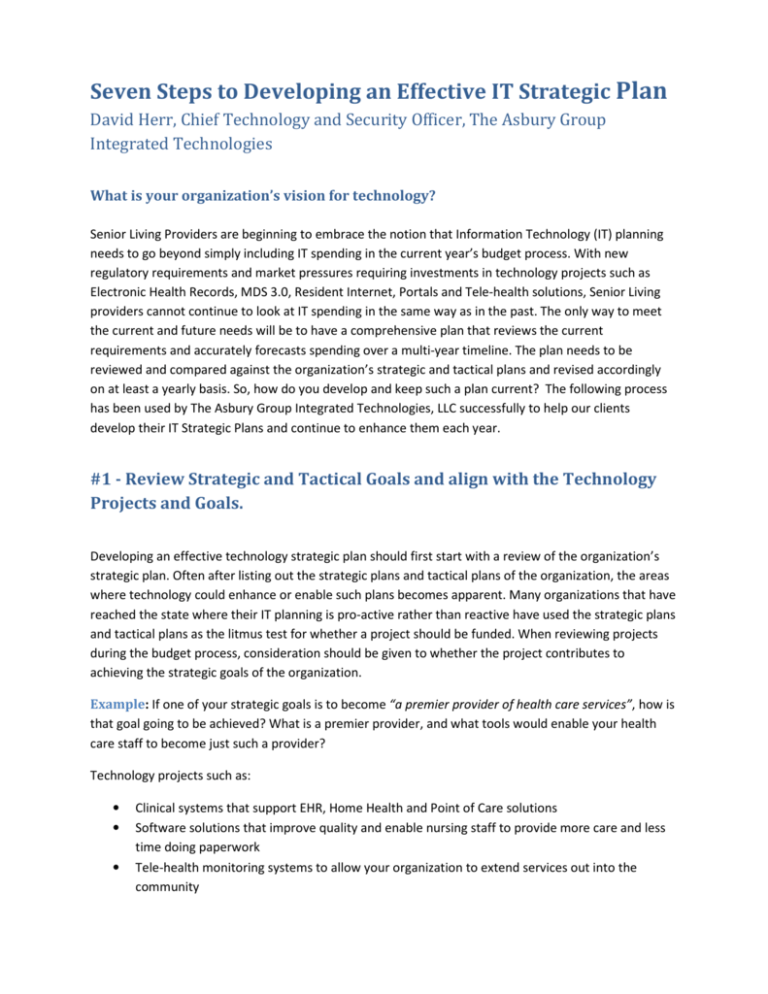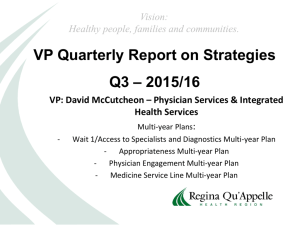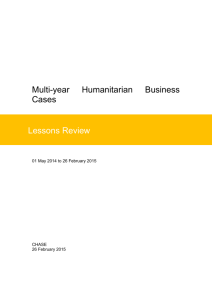Seven Steps to Developing an Effective IT Strategic Plan
advertisement

Seven Steps to Developing an Effective IT Strategic Plan David Herr, Chief Technology and Security Officer, The Asbury Group Integrated Technologies What is your organization’s vision for technology? Senior Living Providers are beginning to embrace the notion that Information Technology (IT) planning needs to go beyond simply including IT spending in the current year’s budget process. With new regulatory requirements and market pressures requiring investments in technology projects such as Electronic Health Records, MDS 3.0, Resident Internet, Portals and Tele-health solutions, Senior Living providers cannot continue to look at IT spending in the same way as in the past. The only way to meet the current and future needs will be to have a comprehensive plan that reviews the current requirements and accurately forecasts spending over a multi-year timeline. The plan needs to be reviewed and compared against the organization’s strategic and tactical plans and revised accordingly on at least a yearly basis. So, how do you develop and keep such a plan current? The following process has been used by The Asbury Group Integrated Technologies, LLC successfully to help our clients develop their IT Strategic Plans and continue to enhance them each year. #1 - Review Strategic and Tactical Goals and align with the Technology Projects and Goals. Developing an effective technology strategic plan should first start with a review of the organization’s strategic plan. Often after listing out the strategic plans and tactical plans of the organization, the areas where technology could enhance or enable such plans becomes apparent. Many organizations that have reached the state where their IT planning is pro-active rather than reactive have used the strategic plans and tactical plans as the litmus test for whether a project should be funded. When reviewing projects during the budget process, consideration should be given to whether the project contributes to achieving the strategic goals of the organization. Example: If one of your strategic goals is to become “a premier provider of health care services”, how is that goal going to be achieved? What is a premier provider, and what tools would enable your health care staff to become just such a provider? Technology projects such as: • • • Clinical systems that support EHR, Home Health and Point of Care solutions Software solutions that improve quality and enable nursing staff to provide more care and less time doing paperwork Tele-health monitoring systems to allow your organization to extend services out into the community #2 – Interview the Executive and the Operational Staff After reviewing the organizations Strategic Goals, the next step is to collect information from the executive and operational staff. This information should be collected in a variety of ways so that common themes can be extrapolated, and that the analysis shows trends and direction. Often people will open up more in individual interviews and others will tend to do better in group settings. We often use the following tools to collect data when helping clients create IT strategic plans: • • • • • Questionnaires and Surveys Strengths/Weaknesses/Opportunities/Threats (S.W.O.T.s) Individual Interviews (Executive and selected staff) Departmental Interviews Interviews with the Board of Directors and Resident Groups The data collected during the process above is then entered into spreadsheets and sorted for common or consistent themes. Example: The survey questions are designed to ask the users of the IT systems to rank their opinions about the mindset of the organization as far as IT investment is concerned. The data collected might be sorted to show the following common issues: • • • The organization as a whole has a desire to be perceived as an “Innovator or Early Adopter” in their use of IT The current state of IT in comparison to other senior living communities is closer to “Laggard or Late Majority” Technology that is currently available to the community is not being used properly, indicating the reasons (e.g. a lack of training or limited support) #3 – Benchmark the Current IT Organization and IT Spending This is one area where it may be more difficult to internally evaluate your existing IT Organization without the assistance of a consulting firm, but here are the important criteria you will want to include in your evaluation. The size and scope of the most IT organizations varies greatly between different senior living providers/settings. This could be due to the various applications or the variety of customers (including both residents and business users in some communities), so each organization is unique. The benchmarking exercise may include the following aspects: • IT Leadership – does your company have a CIO or IT Director in strategic planning and growth? Is IT Leadership proactive or reactive? • • What is the size and scope of the current IT organization? How does this compare to other similar senior living providers? Rank your internal IT staff and responsibilities in comparison to similar senior living providers to determine if your organization is a leader, follower, or laggard in providing IT solutions to your company. Benchmark IT spending against other Senior Living providers to see how your organization invests their IT dollars. We typically find that many senior living providers “think” they are spending enough on IT, but they are really laggards in comparison to senior living organizations that view IT as a strategic investment over their competitors. Example: Take a critical look at how IT is funded in your organization and ask yourself the following questions: • • • • • • Is Information Technology considered a “cost” of doing business or an “enabler” of the business to succeed? Are projects funded based on proactive or reactive thinking? Do you replace systems when they break or are there multi-year plans to upgrade systems? Do you include IT leadership on the organization’s Executive team? How are new corporate directives and goals communicated to IT? Would outsourcing some or all of IT for your organization lower IT expenditures? #4 – Software Application and Systems Review Most senior living communities are currently using applications for the needs of the business departments in the organization. Many of these applications are now highly developed and specialized for our industry, but there are some recognized leaders that are considered “best of breed”. The costs involved in replacing critical applications such as accounting and clinical systems are not to be taken lightly. It is crucial to the continued success of the organization to make informed decisions when looking at potential replacement systems, and ensure that you have all the business needs identified before you begin bringing in vendors for system demonstrations. The best way to start the process is to identify all the applications currently in use in the organization and determine the following: • Review each application and determine with the users if the application is meeting the current needs: o Who are the “owners” of the application? o What are the needs of the current “owners”? o Review the current application and identify where the current application is meeting or not meeting the needs of the department o Determine when the application could be considered for replacement or enhancements (based on not meeting needs, purchase date, regulatory requirements) Example: Your organization is being charged with looking for a new clinical system that will support EHR to meet the new regulatory requirements. Your current clinical system can be upgraded to support EHR but you are not sure that the DON and other users are happy with the current system. A suggested action plan might be: • • • • Identify the current and anticipated needs by interviewing and working with the clinical staff and related departments such as finance) Put the results of the needs analysis into a spreadsheet for review Sit down with your current clinical vendor and determine where the existing application can or cannot meet the needs identified in the steps above Consider performing the same process with alternative vendors, particularly if the current vendor cannot meet the required needs sufficiently #5 – Review the Gaps between the Strategic Goals and the Current Operations This is where the fun begins. You have reviewed the strategic goals of your organization and identified IT related goals. You have interviewed the executive and operational staff to get their input into the IT needs of the organization as well as the current performance of the IT operations team and systems. You have reviewed the existing IT organization, staff and budget and have reviewed the current list of applications and determined whether they are meeting the current needs of the organization, and explored some upgrade or replacement options. Armed with this information, the next steps are to identify the gaps between the desired state and the current state of the IT organization. Examples of some of the gaps could include: • • • • • Growth goals for the organization may not be in line with current IT investment IT staff may be improperly sized to support growth or meet the current needs Software Applications may be identified for replacement sooner than expected End-users lack sufficient training to maximize the use of existing applications IT systems (hardware and infrastructure) may need to be replaced to meet the goals #6 – Develop the IT Short-Term and Long-Term Project Plan/Timeline With the gaps identified, you can now prioritize projects over a multi-year period and create that elusive long-range technology vision. Because of the dependencies upon other IT projects, this is best done by IT staff or consultants with a technology background. At a high-level, the executive leadership can direct the priorities of the organization and then these priorities can be assembled into a project timeline. Example: During the gap analysis, the following projects were identified as being needed to meet the strategic goals of the organization. • • • • Clinical systems that support EHR, Home Health and Point of Care solutions Wi-Fi support for multiple systems across the communities Enhanced training for the clinical staff to support existing applications Access to more computer systems across the organization Based on the gaps above, you could create a multi-year plan that included the following: • • • 1st Year – Add a Clinical Trainer to staff for clinical system support and training, research clinical software solutions and perform a “needs analysis” and clinical application review to determine the process for meeting the new clinical needs (when researching clinical software applications, keep in mind certification for interoperability and the ability to exchange residents’/clients’ health information with other providers when needed) 2nd Year – Implement Wi-Fi technology across the communities to support the wireless business needs. Develop a 3-4 year computer replacement plan to keep the technology refreshed on a regular basis, and add systems to support new applications. Begin first phase of the clinical system implementation to support EHR 3rd Year – Add 2nd support staff FTE (or consider outsourcing alternatives) to the IT budget to support the new clinical system needs. Continue to expand the clinical system to include Home Health and Point of Care needs The IT Strategic Plan that is developed to meet the identified needs of the organization will often be much more comprehensive than most organizations are ready to implement. When looking at the priority projects, the typical options are to build an internal staff to address the priority projects or to outsource the project. Make sure that you have conducted an ROI study on the costs to in-source versus outsource projects so you can make informed decisions. Many organizations are considering outsourcing some or all of their IT systems to allow them to focus on their business strengths. Either way, it is critical that the timeline and project plan above be reviewed at least bi-annually with the executive team and updated accordingly. Your organization should not look at IT only during the budget season. The multi-year approach will let everyone know what is coming each year. #7 – Give Information Technology a “Seat at the Table” Now that you have created the technology vision for your organization, the goal needs to be to continue to update and develop the plan as things change. None of us can anticipate a major downturn in the economy, like the one we recently experienced, or an opportunity for growth in your organization that becomes available a few years from now. It does not matter if your community has a small IT staff or a large one; you need to have someone in the organization that represents the IT department included in your strategic planning and operational planning processes. The only way that your technology vision can be kept current with the organization’s vision is to include them in the process. Example: Here are some ways to accomplish this goal in your organization • • If you are a single site or smaller multi-site with a Director of IT or IT Manager position in your organization, include them in your monthly operations meetings so they have insight into what is going on in the rest of the organization and provide input. Consider having the executive team responsible for strategic planning to meet with them on a bi-annual basis to review the technology vision and discuss changes in the organization’s goals that might affect the plan. For larger organizations, you probably already have a Director of IT or VP/CIO position. Due to the complexity of the growth plans and organization changes, this position should be involved in the executive team handling strategic planning on a regular basis. Consider including them on these teams as well as at board meetings if appropriate. Operations meetings should be also attended on a regular basis so that tactical and strategic performance can be considered as the plan is reviewed. If you follow the above steps as an organization, you will be able to develop an IT Strategic Plan that is in alignment with the organization goals, and will be dynamic and grow with the company. The Asbury Group Integrated Technologies, LLC has been successful in developing such a plan for many leading Senior Living Providers and also provides outsourcing services to our clients. If you have additional questions, or you would like our assistance in developing such a plan, please feel free to reach out to me at dherr@go-tag.net or call The Asbury Group Integrated Technologies, LLC at 1-877-365-8241. Visit our website at http://www.go-tag.net for more information about our services. David Herr Chief Technology and Security Officer 20030 Century Blvd. #300 Germantown, MD 20874 T: 301-250-2046 C: 240-401-0609 F: 877-365-8244









